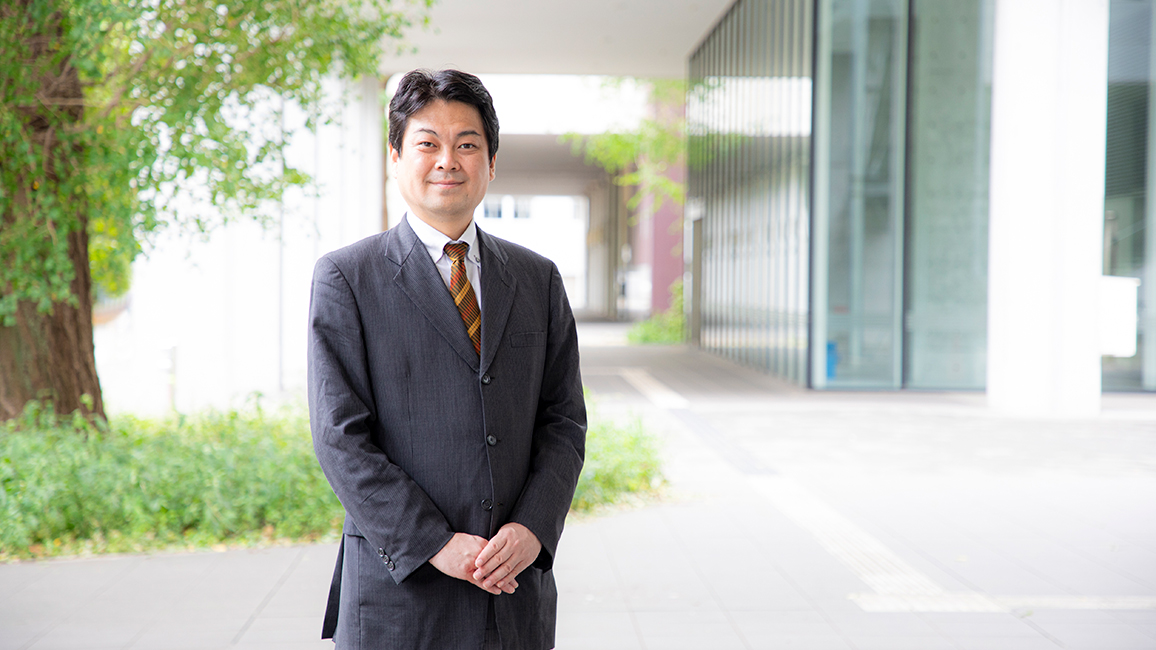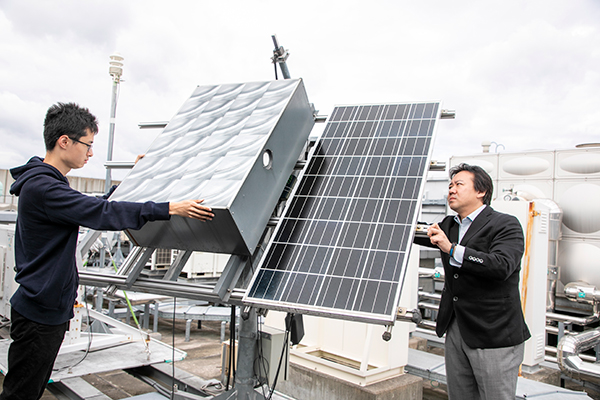- HOME
- Research at RCAST
- Visit to Laboratories
- Sugiyama Laboratory
Sugiyama Laboratory

The promising renewable energy of hydrogen,
and its high-efficiency production using photovoltaic (PV) power generation
The Sugiyama Laboratory for research on energy systems is working on realizing high-efficiency photovoltaic (PV) power generation using semiconductor nanostructures, and building chemical energy storage systems. By converting solar energy into hydrogen using high efficiency and low cost production at regions with a high irradiance, it can be transported to areas in Japan with a large energy demand fuel for power generation. Once this system is completed, solar energy will literally become the core energy that powers society. The lab is focused on developing innovative PV cells using cutting-edge crystalline layer technology.
Making full use of solar energy
Photovoltaic (PV) power generation is gaining expectations as a renewable energy. However, the existing PV panels that use silicon have a efficiency of only around 20% for converting solar energy into electric power. Moreover, this technology is mostly complete, so we cannot anticipate any further improvement in this conversion efficiency.
Then there are the compound semiconductor PV cells, which use various semiconductors that match the light’s energy, and efficiently convert light with a broad range of wavelengths. This can boost the conversion efficiency to a maximum of 47%. The semiconductor component is quite expensive though, and so we’ve made it even smaller than a one-yen coin to keep the costs down. We are also using a condenser lens that works by chasing the sunlight and condensing it into the semiconductor component, which increases the conversion efficiency.
Our lab is currently working on developing a crystalline structure that can further boost the power generation efficiency. Basically, we want to create a crystalline structure with a superior conversion efficiency by combining and layering various crystal materials including indium (In), gallium (Ga), arsenic (As), and phosphorous (P).
Concurrent to our lab research, we are also partnering with Queensland State in Australia to test run this power generation system and benchmark its high efficiency. This involves carrying out large-scale power generation in an area that receives a good amount of sunlight, and using the generated electric power for the electrolysis of water; the resultant hydrogen is then brought back to Japan. Although we have to wait until low-cost water electrolysis equipment is developed before we can actually run this system, once it is available, we believe the Japanese government’s 2050 target of an 80% reduction in greenhouse gases will be viable.
Electric power has been a familiar friend since elementary school
I’ve been interested in electricity ever since I was a kid. My father was an engineer at an electrical substation, and so at home there were lots of papers with blueprints on electric power equipment and other such things; I would often scribble on the back of these papers during my playtime. I think I was quite rare in my elementary school class for knowing so much about the mechanisms of electric power systems, and facts such as an electrical substation has a voltage of 6,600 volts.
Even though I was fascinated with energy, I was also curious about materials; and so I ended up studying chemical engineering as an undergraduate student. The lab (of Professor Hiroshi Komiyama) that I studied at was a little different from pure chemistry, and I became immersed in research on creating semiconductor crystals and metallic thin films, and on designing equipment to manufacture semiconductors. I went on to study electronic engineering and continued with my research that straddled both chemistry and physics. Then from around 2008, I started working on developing high-efficiency PV cells.
My stance is ultimately to come up with realistic solutions to social issues. That’s why I’ve expanded the lab’s outlook to include overseas collaborations, as a way of seeking out the best solutions that will achieve this aim and also addressing the energy issues Japan is facing. I’m using the English proficiency I’ve had since junior high school to also work in other areas that are slightly outside of our research fields, such as the current collaborations with the Queensland Government, Australia.
Interdisciplinary research for resolving real-life issues
At the Sugiyama lab our aim is to cultivate researchers that can understand both electricity and chemistry. Once you get down to the core of semiconductor research, you also have to consider the behaviour of atoms, and then naturally and inevitably you are led into the field of chemistry.
While we are dedicated to doing research at a micro-level, we want our researchers to develop a macro perspective as well. Finding solutions to energy problems requires not only scientific principles, but also resolving issues related to volume and cost at the same time. You need to know the sociological aspects of running a system in the real world, and you also have to consider international security issues when transporting hydrogen that is produced overseas. Fortunately, we have numerous experts from various fields working at RCAST, and once they’ve decided on a theme, the researchers here can launch a project quite freely and work on the issues they are seeking solutions for.
The Sugiyama lab is outfitted with leading-edge equipment for conducting research in a state-of-the-art environment. It’s also easy to run real-life trials of your research results here - I believe this is the overwhelming appeal of doing research at RCAST. We welcome anyone who is interested in interfaces to join our lab; it can be between research and society or electricity and chemistry – any interface is ok. We are looking for people with a broad range of interests – not just fixated on chemistry and physics - and who can work independently and proactively.




